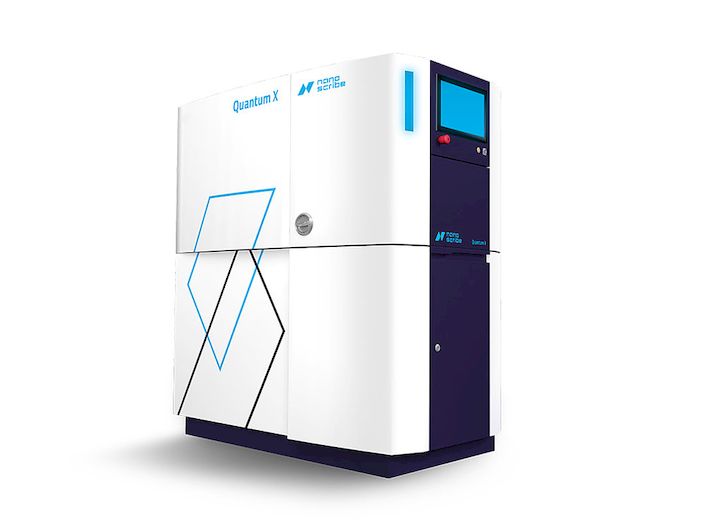![The Quantum X microfabrication production 3D printer [Source: Nanoscribe]](https://fabbaloo.com/wp-content/uploads/2020/05/csm_Nanoscribe_QuantumX_img_5eb092ade2470.jpg)
Nanoscribe announced the new Quantum X microfabrication 3D printer.
There are now many different niches within the field of 3D printing, and one of them is microfabrication. This is the science of 3D printing extremely tiny objects that would be impossible to produce on most common 3D printers. Sometimes the microprints are so small you cannot even see them without visual magnification aids.
The 3D printing process used by Nanoscribe is quite unique. We first investigated it in 2015 when we discovered it uses very high-end optics to focus laser beams down to microscopic widths. Then in 2016 we learned of their highly unusual “3D 3D printing” process, in which solidification occurs in 3D space within droplet of specialized resin.
They’re able to do this due to their patent-pending Two-Photon Grayscale Lithography process, which they abbreviate as “2GL”. This involves a specialized resin that solidifies only when multiple photons strike it. This allows them to create a focal point for the laser energy deep (and we’re talking millimeters here) within the resin droplet and have solidification occur only at the focal point.
The now 70-person German company has released their latest device that uses 2GL: the Quantum X. They explain what the Quantum X can do:
“Quantum X controls the voxel size along one scanning plane using synchronized laser power modulation at high speeds. In this manner, complex shapes are produced and variable feature heights are achievable within one scan field. Discrete and accurate steps as well as essentially continuous topographies can be printed on up to six-inch wafer substrates without the need for additional lithography steps or mask fabrication.”
Quantum X Specifications
The specifications for the Quantum X are in an entirely different league when compared with typical 3D printers. For example, the minimum XY feature size is 160nm. That’s NANOMETERS, not micrometers! In millimeters, that is 0.00016mm. Vertical steps can be as small as a mere 10nm.
The print speed is quite unusual. While the Quantum X specifies a laser scan speed of around 250mm/s, which is quite fast as 3D printers go, each print would be composed of vastly more layers due to the incredibly small feature size. Nanoscribe says the Quantum X can 3D print a 3mm cube in approximately one hour, so you can get a perspective on the machine’s speed.
![The build plate for the Quantum X microfabrication 3D printer uses cells [Source: Nanoscribe]](https://fabbaloo.com/wp-content/uploads/2020/05/image-asset_img_5eb092ae3282e.jpg)
Printing takes place on special “wafers” that contain cells filled with the specialized resin. This allows the Quantum X to work on a number of microparts within a single job run. The entire printing area is 50 x 50 mm.
Quantum X Production 3D Printer
The Quantum X is designed for production, and it includes a number of features to facilitate that capability. For example, the system includes automatic calibration and real-time monitoring of print jobs, which can be done through a remote control interface. Apparently there are three different live-view cameras able to monitor activity. Job preparation can be done through a wizard that allows for less experienced operational staff to get going more quickly.
The Quantum X does require some environmental considerations before deciding on a purchase. It weighs an astounding 1200kg, which might be a challenge for some workshop floors. It also requires an operating temperature of 20C, plus or minus only 2 degrees. That’s pretty tight. In addition to 16A power, the Quantum X also requires an external compressed air supply of 6-8 bar.
3D Printed Lenses
![Example of 3D printed micro-lenses [Source: Nanoscribe]](https://fabbaloo.com/wp-content/uploads/2020/05/image-asset_img_5eb092ae7764e.jpg)
You’re probably wondering exactly what a device like this could be used for. The Quantum X is specifically designed to produce diffractive and refractive microoptics: lenses. With its incredible resolution it is possible to print high-quality optics.
But by leveraging 3D printing’s ability to create arbitrarily complex geometries, it would be entirely possible to create radically new types of lenses with this machine. These would be used in highly specialized applications to bend light in very unusual ways.
Via Nanoscribe











Researchers have been able to design a new 3D printing system that effectively parallelizes the familiar two-photon laser approach to achieve fantastic print speeds.